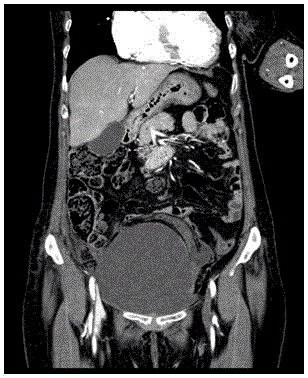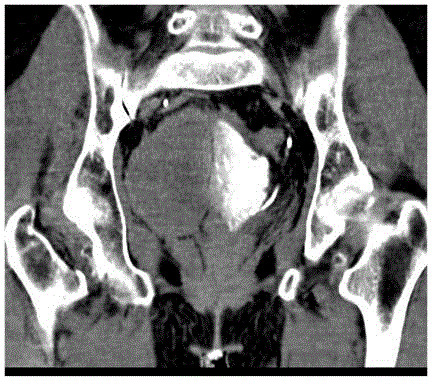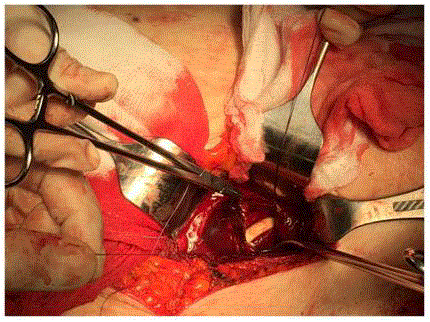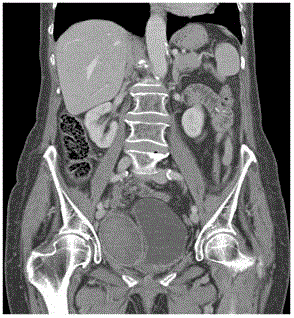Case Report
Surgical Management of A Rectus Sheath Hematoma Perforating the Bladder Wall: Multidisciplinary Approach & Literature Review
Depalma N, Toccaceli S* and La Torre F
Department of Emergency Surgery, Policlinico Umberto I, Italy
*Corresponding author: Department of Emergency Surgery, Policlinico Umberto I, Italy
Published: 07 Jun, 2017
Cite this article as: Depalma N, Toccaceli S, La Torre F.
Surgical Management of A Rectus
Sheath Hematoma Perforating the
Bladder Wall: Multidisciplinary Approach
& Literature Review. Clin Surg. 2017;
2: 1497
Abstract
The Rectus Sheath Hematoma (RSH) accounts only for less than 2% of patients presenting with
acute abdominal pain. In the majority of cases it’s due to a spontaneous self-limiting bleeding from
the inferior epigastric artery (IEA) and the treatment is conservative. We present the case of a 71
year-old woman assuming warfarin for persistent atrial fibrillation that underwent an intervention
for pacemacker RCT-D positioning, who developed a large RSH invading the pelvis and eroding
into the bladder wall, causing gross haematuria. This case reports highlights the uniqueness of this
particular presentation and the necessity of an emergency surgical management based on the patient
haemodynamic instability and hematoma characteristics.
Keywords: Rectus sheath hematoma; Bladder perforation; Hypovolemic shock
Introduction
Rectus Sheath Hematoma (RSH) accounts only for less than 2% of patients presenting with acute abdominal pain [1,2]. It is proven to be more common in women than men, at a ratio of 2-3:1, and it seems to increase with age [3,4]. In the majority of cases it’s due to a spontaneous bleeding from the inferior epigastric artery (IEA) and the most predisposing factors are trauma [3,4], anticoagulation therapy [3,5], surgery/iatrogenic, cough/intense rectus muscle contraction, pregnancy, various medical conditions that cause damage to blood vessels or coagulation disorders. RSH enters into many differential diagnoses, including appendicitis, periappendiceal abscess, abdominal wall tumors and hernias, and acute splenic, biliary, diverticular, gynaecologic, or genitourinary disease, posing a diagnostic dilemma in clinical care. Considering that, with the advent of anticoagulation therapy and a prolonged life expectancy, the risk of RSH is slowly increasing [6], this case report aims to focus on the importance of a prompt identification and a correct management in order to avoid several misdiagnoses or in some cases even death. It also is the first description of a RSH eroding into the bladder wall causing bladder perforation and extra-peritoneal haemorrhage, subsequently treated with emergency surgery.
A 78-year-old woman with a prior intervention, in 2003, of aortic valve replacement and coronary artery bypass graft had been admitted to our Department to evaluate suspected prosthesis degeneration. She had been suffering persistent atrial fibrillation and had been assuming Warfarin as anticoagulation. After cardiac surgeon and cardiologist evaluation, she underwent an intervention for pacemaker RCT-D (Cardiac resynchronization therapy – defibrillator) positioning and suspended warfarin, bridging her therapy with low-molecular-weight heparin. Two days after the procedure, she began to complain of increasing abdominal pain. On physical examination, she had a visible distended abdomen and a palpable, non-fluctuating mass with tenderness and guarding in the right lower quadrant. Blood pressure was 90/60 mmHg. A urinary catheter was placed and the patient was found anuric. Hemogasanalysis was normal. A hemoglobin drop from 10.4 to 7.7 g/dl was found and a computed tomography (CT) scan showed a large hematoma in the lower abdomen and pelvis, originating from a smaller one hematoma observed into the right abdominal rectus muscle, but no active bleeding was identified. After 3 hours of observation the patient conditions worsen, with dyspnea, blood pressure 80/50 mmHg and a new decrease in haemoglobin level to 6.6 g/dl, despite running transfusions of packed red blood cells. A new, urgent CT scan was advised in order to eventually find the source of bleeding. During the exam the patient referred a feeling of “emptying” and, concurrently, gross hematuria was observed from the urinary catheter, while CT scan showed the hematoma’s spontaneous drainage into the bladder, through a bladder wall perforation (Figure 1a and 1b). The patient, haemodynamically unstable, was carried in the operating room and a laparotomy was performed, with hematoma evacuation, bladder repair and ligation of the inferior epigastric artery, which was clearly identified as the bleeding source (Figure 2). Histological specimens of the bladder wall were taken and resulted negative for the search of neoplastic cells. After surgery the patient was extubated and transferred in our ward in stable conditions. The urinary catheter was left in for only 3 weeks in order to protect the suture and it was removed after a cystographic control. The patient was discharged in good conditions after 18 days. As completion of follow-up examination an abdominal CT scan was performed 1 month after, and showed a partial reduction of the RSH and no active bleeding sites (Figure 3).
Discussion
The arterial supply of the rectus abdominis muscle derives from
the epigastric arteries. The inferior epigastric artery (IEA) runs loosely,
superiorly on the posterior surface of the rectus abdominis and enters
the sheath at the arcuate line (semicircular line of Douglas). This
combination of loose and fixed branches leads the IEA more prone to
injury, during strong muscle contractions and this explains why RSH
seems to occur more often in the lower quadrant of the abdomen.
Furthermore ruptures of the superior epigastric artery usually result
in small, self-limiting hematomas, in contrast to those caused by IEA
rupture, that are less restricted because of the absence of posterior
rectus sheath below the arcuate line [2,4].
Clinical diagnosis of RSH is based on a variety of signs and
symptoms such as abdominal pain, palpable abdominal wall mass,
tenderness, abdominal guarding, nausea, vomiting and eventual
hemodynamic instability. Carnett's sign and Fothergill's sign can help
distinguish whether the tenderness originates intra-abdominally or
from the abdominal wall [4]. Nowadays, though, ultrasonography
(US) and computed tomography (CT) has become the keystone
in diagnosing RSH, having the CT scan sensitivity and specificity
reaching 98% [7].
In our specific case, we found a type III hematoma, according to
the CT classification proposed by Berna et al. [8], which extended
into the prevescical space of Retzius and perforated the superior wall
of the bladder, causing gross haematuria. In our opinion the cause of
the erosion likely involves pressure necrosis and pressure differentials
after the insertion of the urinary catheter in a collapsed bladder; but
it might also derived from a locus minor is resistentiae due to a
weakened native tissue.
Ada and Sandoval et al. [9,10] reported three cases of RSH
perforating the bladder, all of them treated conservatively with a
6 week Foley catheter drainage. One of them though developed a
bladder fistula that needed a subsequent treatment. In our case,
instead, because of the hemodynamic instability of the patient and
the acute abdominal pain presentation, it was chosen a surgical
management in emergency conditions in order to evacuate the
enlarging hematoma perform the IEA ligation and repair the bladder
perforation. This leaded to a rapid hemodynamic stabilization and a
fast mobilization of the patient with the urinary catheter left in for only 3 weeks. During the surgical follow-up the 1 month CT-scan
control revealed a reduction of the hematoma, the absence of bladder
fistulas, and no other complications [11].
Figure 1a
Figure 1a
Coronal slice of the CT scan showing the large rectus sheath
hematoma totally compressing the bladder.
Figure 1b
Figure 1b
Coronal slice of the CT scan after urinary catheter insertion
showing a partial ri-expansion of the bladder and hematoma drainage
through the bladder perforation.
Figure 2
Figure 2
Hematoma evacuation and bladder wall repair. The Foley catheter
is seen through the perforation
Figure 3
Figure 3
Coronal slice a the CT scan control 1 month later showing the
reduction of the rectus sheath hematoma and the complete integrity of the
bladder wall.
Conclusion
The vast majority of RSH can be treated conservatively, because usually the hematomas are self-limiting. Although, invasive haemorrhage control of RSH should be considered in hemodynamic unstable patients that don't respond to fluid resuscitation, with enlarging hematomas, severe peritoneal irritation or gross haematuria in acute bladder perforation.
References
- Klingler PJ, Wetscher G, Glaser K, Tschmelitsch J, Schmid T, Hinder RA. The use of ultrasound to differentiate rectus sheath hematoma from other acute abdominal disorders. Surg Endosc. 1999;13(11):1129-34.
- Hatjipetrou A, Anyfantakis D, Kastanakis M. Rectus Sheath hematoma: A riview of the literature. Int J Surg. 2015;13:267-71.
- Cherry WB, Mueller PS. Rectus sheath hematoma: review of 126 cases at a single institution. Medicine (Baltimore). 2006;85(2):105-10.
- Teske M. Hematoma of the rectus abdominis muscle: report of a case and analysis of 100 cases from the literature. Am J Surg. 1946;71:689-95..
- Levine MN, Raskob G, Landefeld S, Kearon C. Hemorrhagic complications of anticoagulant treatment. Chest. 2001;119(1):108S-121S.
- Parkinson F, Khalid U, Woolgar J. Rectus sheath haematoma: a serious complication of a commonly administered drug. BMJ Case Rep. 2013;2013.
- Fukuda T, Sakamoto I, Kohzaki S, Uetani M, Mori M, Fujimoto T, et al. Spontaneous rectus sheath hematomas: clinical and radiological features. Abdom Imaging. 1996;21(1):58-61.
- Berná JD, Garcia-Medina V, Guirao J, Garcia-Medina J. Rectus sheath hematoma: diagnostic classification by CT. Abdom Imaging. 1996;21(1):62-4.
- Ada S, Yalamanchili M, Gottileb P. Rectus sheath hematoma eroding into the bladder wall causing extraperitoneal bladder rupture and vescico-hematoma fistula. Am J Med. 2002;113(6):530.
- Sandoval O, Kinkead T. Spontaneous rectus sheath hematoma: an unusual cause of gross hematuria. Urology. 2013;82(6):e35-6.
- Higgs AM, Smith FCT. Surgical management of massive rectus shetah hematoma due to inferior epigastric artery rupture. EJVES Extra. 2005;9:93-5.




